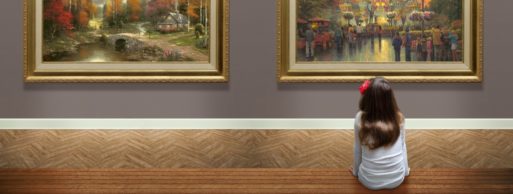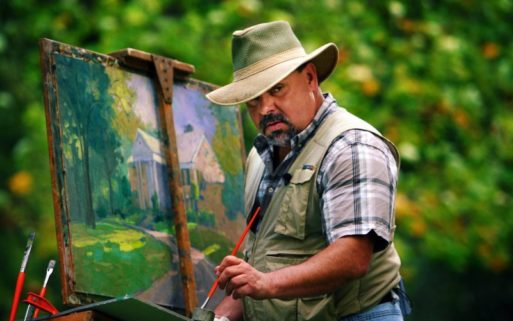
“And I remember imagining that all these people were alive and well just because the lights were on in their homes.”
(Credit: thomaskinkade.com/the-art)
Growing up, the Thomas Kinkade store in Staten Island Mall served as a landmark to me and my family. Some of my most distinct childhood memories are of roaming those aisles of paintings for hours, while my mom and aunt admired them and struggled to choose their favorite images. These were the days I dreaded as a kid: I would have much rather been admiring a set of swings on a playground or an ice cream pop melting in my hands. But looking back now, I have nothing but appreciation for these memories because, as it turns out, all those hours spent looking at Kinkade’s work taught me a great deal about the relationship between contradictions, specifically the ceremonial pairings of light and life, and darkness and death.
If you’ve ever looked at a Thomas Kinkade painting, it’s easy to see why he named himself the Painter of Light; almost every one of his pictures encompasses multiple forms of light, either natural sunlight or light streaming from cottage windows, street lamps or automobiles. Looking at his work through innocent eyes, I used to make up stories about people living in the cottages or driving through the streets. I would move from painting to painting, connecting each anecdote as I went, pretending that the Johnson’s were cousins to the Smith’s, who were friends with the O’Neill’s, who knew the Davis’s. And I remember imagining that all these people were alive and well just because the lights were on in their homes.
That was when I was a child. Now, after maturing a bit and experiencing some of the curveballs life throws at us, I have found new insights into Kinkade’s work. After my aunt (who loved his art and owned five of his paintings) died in 2004, I began to see it not just as the backdrop for a story, but the story itself.
The beauty of Kinkade’s paintings is that they are arbitrary. You can see anything you want to see. His predominantly pastoral scenes, most of which are sans people, shine beams of light on certain places while casting shadows on others. His pictures highlight what draws his audiences in: beautiful houses, stone-paved walkways, cotton-candy skies, thriving evergreens — but there is so much more.
Looking closely, Kinkades’ attention to detail shows in every part of his art, regardless if whether it is centered in the light or not — the lilies budding in the garden, the ripples in the water, the fog in the distance — this is how his art correlates to our everyday lives. We tend to shed light on the things we want to see and push those we don’t want to acknowledge into the darkness. Kinkade’s work shows us that we must learn to embrace the darkness too, as it completes the whole picture of life.
Where there is light, there is also darkness. Similarly, where there is life, death is inevitable. Loss cannot be erased from the picture of our lives. But, if we can begin to see dying as yet another component of the whole, we may learn to find acceptance and a deeper appreciation for life.
You can visit Thomas Kinkade’s website here.

 The Painter Who Followed the Light
The Painter Who Followed the Light




 Our Monthly Tip: Make an “In Case of Death” File to Ease Loved One’s Grief
Our Monthly Tip: Make an “In Case of Death” File to Ease Loved One’s Grief
 Passing of Beloved Comedian Births a New Comedy Festival
Passing of Beloved Comedian Births a New Comedy Festival















